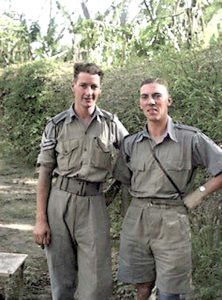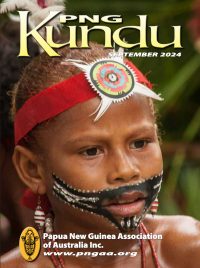Honouring Max
Part Two: Max Macgowan & John May, Rabaul, 1941
By Tempe Macgowan (TM) & Marian May (MM)
This article continues from Part One of the PNG Kundu June 2024 issue. It was co-written by Tempe Macgowan and Marian May, honouring the life of Max Macgowan, one of the 1,054 prisoners who lost their lives on Montevideo Maru in 1942. It also celebrates the wartime friendship between Marian’s father, Padre John Lovett May, and Tempe’s uncle, Max Macgowan who perished at age 26.
The last news of Max and John for a very long time was letters written on 24 March 1942. In an unusual gesture, the Japanese commandant allowed the POWs to write a letter; four bags were dropped during a raid on Port Moresby ‘instead of a bomb’. Many could not be retrieved, but Max’s and John’s letters were eventually delivered. John’s letter reads in part:
Best of all, Max & Lance [Howlett, John’s batman] are with me. We are all well, though Max’s tinea is not the best. Will you get in touch with Mrs. Macgowan, 6 Montague St., East St. Kilda? Max is telling her to write to you. … Max and I are going to join a wealthy club after the war and make cigarettes out of the cigar butts.
Max adds a postscript:
Hallo [sic], we are doing fine & our chins are up. God bless you. Love Max.
In 2022, searching for some information about my grandmother, I came across a small package containing letters between Mollie Macgowan and John’s mother, May Louise May, written during the months when the two men were missing in Rabaul.
TM: The five letters from Mollie to May Louise May (née Lovett) trace such a heartfelt relationship. They swing between hope and despair, depending on whether they have heard anything about their sons. On 18 April 1942, Mollie writes:
… It has occurred to me that you may not have heard – have had an opportunity in Tasmania, of … with news of the boys who escaped from Rabaul … If I hear any further news … I’ll write you further … We have been very happy about Max’s friendship with John.
Mollie writes:
I suppose you have also received a letter from Rabaul. I really am on top of the world, although I know the fact remains that they are still prisoners of war … to know that they are safe.
John remembered:
It was the first word that they had of us. For some, it was the only word.
On 28 April John followed Max back to Malaguna Camp for POWs and internees in Rabaul. Then on 22 June, Max left to board Montevideo Maru.
In his few letters home from Zentsuji POW Camp in Japan, John mentions Max in August 1942:
Tell Mrs Macgowan, 6 Montague St., East St Kilda, that Max was well and in good spirits. He left before I did.
And almost two years in captivity and no mail, in December 1943:
If you do not know, I was captured, unharmed, Kokopo Hospital, 23 January … All except officers had left [censored] 22 June. Max and most O.K.
By April 1944 there was still no word of those who had left on Montevideo Maru:
We hope you have heard of Max and the rest. Love and prayers, Johnny.
After the War
MM: It was in Manila after liberation in September 1945, that John sent news of Max to his parents:
For your own information – I think the official report will soon come out—we can find no trace of all the civilians & troops who left us in Rabaul on 22 June 1942. The ship they were in was probably lost – Max & all the others with it. I had asked the Japs to let me go as chaplain with that party!
TM: Whilst in 1945 the war authorities had a list of names compiled by Major Harold S Williams of the No. 1 Australian Prisoners of War Contact and Enquiry Unit, it is unclear whether Max’s parents knew of the exact circumstances of his death before they died in 1950 and 1951.
MM: I’m fairly sure that on his return, Dad visited Max’s family. He spent several weeks in Melbourne in November – December 1945 visiting families of those last seen in Rabaul. He told Lot:
… It has been a pretty sad time … with people for whom the light has suddenly gone out of life.
It is ironic that war brought Max and John together, and war that destroyed their friendship.
TM: Marian and I met in late 2022, with my daughter, to go through the correspondence and other effects. It was a truly moving experience to handle the pages written by our grandmother, Mollie, who died several years before any of my sister and I were born.
Shiela’s children, however, do remember her, as they were that bit older. They would spend time with them at Dromana on the Mornington Peninsula. Both Dinah and Hope Dodds remember Cliff, my grandfather, being a stamp collector.

This is the envelope of John May’s letter of 27 March, 1942, dropped over Port Moresby ‘in place of a bomb’
Dinah has passed on photos of Mollie and Cliff. The ones of Cliff are the first photos that I and my sisters have ever seen of them, other than a studio photo of Mollie. The family resemblance is striking between our father Murray, Max’s youngest brother, and their father Cliff. Another striking likeness was that between Max and his great-nephew, Kip, Dinah’s son, who also died tragically at 26. Identifying the similarities has brought some solace to Kip’s parents.
We were also quite unfamiliar with the circumstances in which the family lived. John’s letter from 16 November 1941 pretty much sums up what the situation was like for our father, Murray, and the family:
Maxwell Harcourt Glover Macgowan, living at 6 Montague St., East St. Kilda, with a father and mother, a sister (younger) and a younger brother, still (as was Max) at Caulfield Grammar. Before the war, he used to be in Paterson, Laing, and Bruce, the cloth merchants in the city, as a salesman. I’m just not quite sure how old he is, but he’s a little younger than I am. Shiela his sister, has just passed her training at the Alfred Hospital and has begun a job at Gundagai.
Mr. Macgowan has had several jobs under way, lately, including newspaper reporting, a business of sand-refining, and retailing, and a motor garage. I think they are not particularly well off, and have a bit of a struggle at times. They speak to Max of moving up to Upwey, in semi-retirement, and neither Mr. nor Mrs. is very well. There they will be quieter and Mr. M. can do sufficient newspaper work to keep things going. They seem to be a very pleasant home-loving family.
Max is engaged to a girl named Joyce Williams, who is a typist, stenographer, clerk, or what-have-you, in a fairly big building firm. She looks nice in the photos, of which Max has dozens. (Max was born 10-3-16.)
Sharing the correspondence with my sisters and cousins has been a gratifying outcome of what was such a tragic incident. It has brought us together and allowed us to overcome some differences that existed between us. It has meant reconnecting with Laura’s mother, Sacha, who lives in the same house that we visited as children when her parents, Margaret and Peter, were alive. Now I at least have some sort of family to refer to on our dad’s side, that came from that one auspicious text sent in July 2022.
Postscript
MM: Some of Dad’s photos (previously published in PNGAA’s When the War Came) were on the walls in the operations room for the search for Montevideo Maru, including one of Dad and Max, and one of the group of officers in the POW camp in Japan. By chance, Tempe and I were speaking on the phone when the photos were visible for a short time on SBS footage. I know the officers would have wanted to be there, searching for their men—so in a way they were.
Part 1 can be found HERE.




